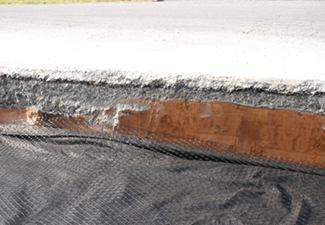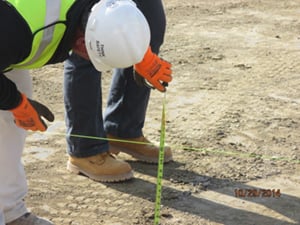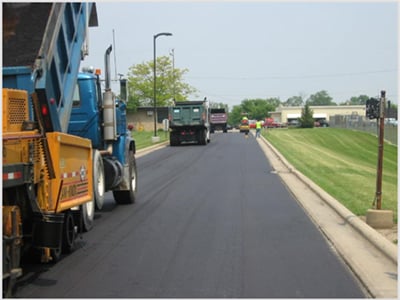Minimize paving project costs with expert financial management.
By: Troy Kaiser
Senior Consultant
Nothing can make the financial management of a pavement construction project more difficult than additional work that results in contract change orders. When a budget is set for a project, there is rarely a limitless pool of funds that can be drawn from if the project costs go up. The challenge for the managers or owners of these projects is to do everything possible to ensure change orders are eliminated or kept to a minimum. Of course, unforeseen issues can arise during a paving project that requires the contractor to do work above and beyond the original scope, but there are steps that can be taken to eliminate or reduce the amount of these changes.
Geotechnical Exploration
The first step an owner or manager can take to reduce the risk of unforeseen extras during a paving project is to have a geotechnical exploration of the existing conditions completed. This involves coring the existing pavement and then boring into the lower layers, usually to a depth of three to five feet. From these borings, the geotechnical firm will supply information on the depth of the existing pavement and stone base course as well as the type and condition of the subgrade soils. This information is invaluable during the design phase of a paving project. By knowing the existing conditions, the new pavement can be designed based on known facts and not on assumptions about the existing conditions. This is a big step in reducing change orders for unforeseen work.

Geotechnical investigation helps identify issues with the original construction.
Detailed Plans & Specifications
The next step to reducing change orders is to have detailed plans and specifications for the contractors to bid on. Far too often, a paving project has no plans and specifications and the owner/manager must rely on the contractors to determine how the project is built. This can lead to the contractors recommending different solutions, which leads to the owner comparing apples to oranges when trying to decide on the best and most cost-effective plan of attack. Detailed specifications ensure all the bids are for the same scope of work so the owner/manager can make an informed decision on whom to award the project to. Bid documents that are site-specific and detailed will reduce the chance of missed scope of work during the design phase, which could result in added costs during construction. Plans and specifications also set the expectations for how the work will be completed.
Unit Pricing
Unit price bidding is a bidding process where the contractors supply prices for each individual item of work verses submitting a lump sum bid. With this approach, the contractors are only paid for the quantities of each item they complete. For example, if they install 300 linear feet of curb and gutter, they are paid their unit price bid for curb and gutter multiplied by 300 linear feet. This is a fair practice as the contractor is paid for what they do and the owner does not end up paying for extra “fluff” that can be included in lump sum bids. This also allows the owner to better control additional costs if they want to increase or reduce the scope of a project as the prices are set at the time of competitive bidding and not calculated by the contractor after they already have the project, which can result in higher prices.
Contingency Items
Along with unit pricing, the addition of contingency items on the bid form for potential unforeseen work during the initial bidding process will help budget for and control additional costs and change orders. Adding items such as a utility repair allowance, subbase stabilization, or asphalt base patching will lock in prices for these items in case they are needed. As long as the contractor knows that these are contingency items during the bidding process, there is nothing wrong with an owner including them with the other bid items. This is another tool the owner can use to reduce the possibility of additional costs associated with contractors pricing items after the project has already started. It also allows the owner to instantly know what an additional cost will be and its impact on the project budget.
Project Oversight
Most owners or managers do not have time to properly supervise a paving project. Although the cost of the project does not increase initially, it could be affected two ways when a contractor does not construct a project per the planned design. The first impact is that the life expectancy of the new pavement could be less (if not installed correctly), which, in the long run, reduces the value received during construction. Secondly, the owner is paying for premium work and could end up with a substandard product if the project is installed per the design. Hiring a professional to be on site during construction ensures the contractor will follow the plan and specifications, the subsurface pay items are verified and recorded before they are covered up, and someone with paving knowledge is available to approve or reject decisions that will impact the quality and cost of the project.

Professional project management and inspection controls the costs of construction.

Quality Contractors
Choosing the right contractor for your project will reduce the potential for change orders leading to additional costs. A quality contractor will spend more time reviewing the plans and specifications and visit the site during the bidding process, which reduces the chance of missed items in their bid. A good contractor will also take responsibility if they do miss something that was in the bidding documents and not go back to the owner for additional compensation. When asked to provide additional pricing for unforeseen items, a quality contractor will submit prices that are in line with the prices they submitted during the initial bidding process and not take advantage of raising the prices. Prequalifying the contractors before inviting them to bid on your project by checking references and even visiting some of their previous projects is time well spent.

Hiring quality contractors reduces cost over-runs and change orders.
The owner or manager may not be able to eliminate budget overruns on every paving project, but by following these suggestions, they can be proactive and significantly reduce situations that lead to change orders and additional costs.

